engine CADILLAC SRX 2016 2.G Owners Manual
[x] Cancel search | Manufacturer: CADILLAC, Model Year: 2016, Model line: SRX, Model: CADILLAC SRX 2016 2.GPages: 319, PDF Size: 3.29 MB
Page 273 of 319
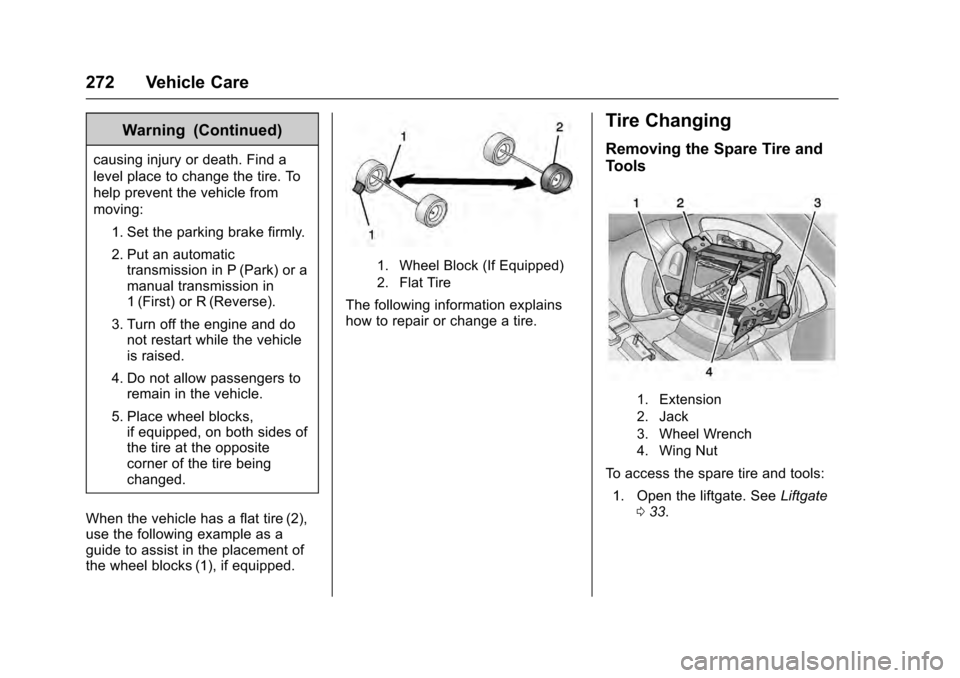
Cadillac SRX Owner Manual (GMNA-Localizing-MidEast-9369636) - 2016 -
crc - 6/1/15
272 Vehicle Care
Warning (Continued)
causing injury or death. Find a
level place to change the tire. To
help prevent the vehicle from
moving:1. Set the parking brake firmly.
2. Put an automatictransmission in P (Park) or a
manual transmission in
1 (First) or R (Reverse).
3. Turn off the engine and do not restart while the vehicle
is raised.
4. Do not allow passengers to remain in the vehicle.
5. Place wheel blocks, if equipped, on both sides of
the tire at the opposite
corner of the tire being
changed.
When the vehicle has a flat tire (2),
use the following example as a
guide to assist in the placement of
the wheel blocks (1), if equipped.
1. Wheel Block (If Equipped)
2. Flat Tire
The following information explains
how to repair or change a tire.
Tire Changing
Removing the Spare Tire and
Tools
1. Extension
2. Jack
3. Wheel Wrench
4. Wing Nut
To access the spare tire and tools: 1. Open the liftgate. See Liftgate
0 33.
Page 281 of 319
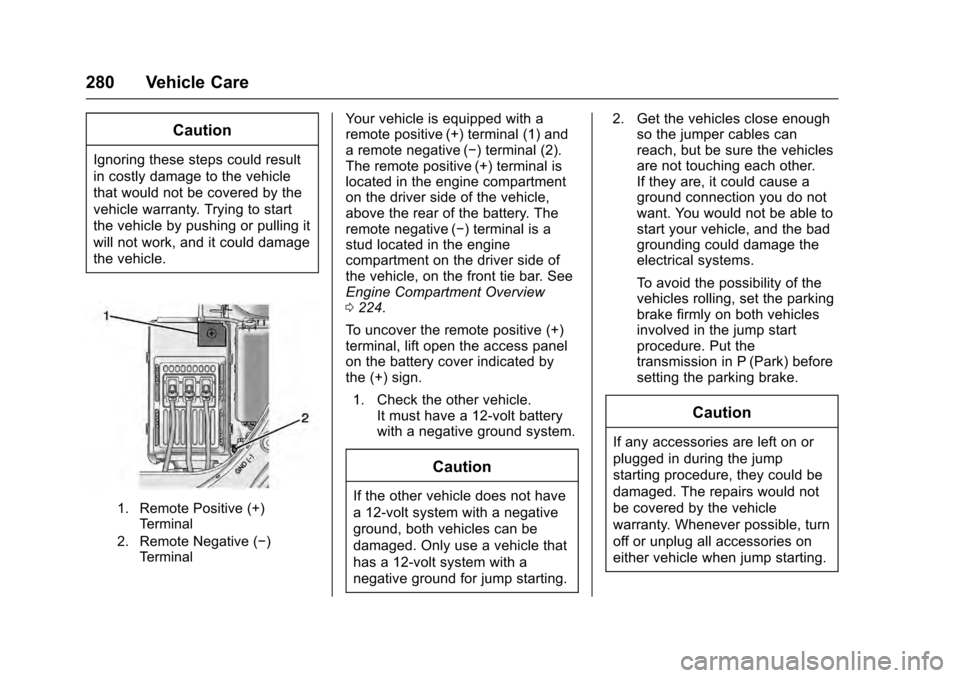
Cadillac SRX Owner Manual (GMNA-Localizing-MidEast-9369636) - 2016 -
crc - 6/1/15
280 Vehicle Care
Caution
Ignoring these steps could result
in costly damage to the vehicle
that would not be covered by the
vehicle warranty. Trying to start
the vehicle by pushing or pulling it
will not work, and it could damage
the vehicle.
1. Remote Positive (+)Terminal
2. Remote Negative (−) Terminal
Your vehicle is equipped with a
remote positive (+) terminal (1) and
a remote negative (−) terminal (2).
The remote positive (+) terminal is
located in the engine compartment
on the driver side of the vehicle,
above the rear of the battery. The
remote negative (−) terminal is a
stud located in the engine
compartment on the driver side of
the vehicle, on the front tie bar. See
Engine Compartment Overview
0224.
To uncover the remote positive (+)
terminal, lift open the access panel
on the battery cover indicated by
the (+) sign. 1. Check the other vehicle. It must have a 12-volt battery
with a negative ground system.
Caution
If the other vehicle does not have
a 12-volt system with a negative
ground, both vehicles can be
damaged. Only use a vehicle that
has a 12-volt system with a
negative ground for jump starting. 2. Get the vehicles close enough
so the jumper cables can
reach, but be sure the vehicles
are not touching each other.
If they are, it could cause a
ground connection you do not
want. You would not be able to
start your vehicle, and the bad
grounding could damage the
electrical systems.
To avoid the possibility of the
vehicles rolling, set the parking
brake firmly on both vehicles
involved in the jump start
procedure. Put the
transmission in P (Park) before
setting the parking brake.
Caution
If any accessories are left on or
plugged in during the jump
starting procedure, they could be
damaged. The repairs would not
be covered by the vehicle
warranty. Whenever possible, turn
off or unplug all accessories on
either vehicle when jump starting.
Page 282 of 319

Cadillac SRX Owner Manual (GMNA-Localizing-MidEast-9369636) - 2016 -
crc - 6/1/15
Vehicle Care 281
3. Turn off the ignition on bothvehicles. Unplug unnecessary
accessories plugged into the
cigarette lighter or the
accessory power outlet. Turn
off the radio and all lamps that
are not needed. This will avoid
sparks, helping save both
batteries and the radio.
4. Open the hood on the other vehicle and locate the
positive (+) and negative (−)
terminal locations on that
vehicle.
Open the hood on your vehicle
and find the remote positive (+)
and remote negative (−) jump
starting terminals.
{Warning
An electric fan can start up even
when the engine is not running
and can injure you. Keep hands,
clothing, and tools away from any
underhood electric fan.
{Warning
Using an open flame near a
battery can cause battery gas to
explode. People have been hurt
doing this, and some have been
blinded. Use a flashlight if you
need more light.
Be sure the battery has enough
water. You do not need to add
water to the battery installed in
your new vehicle. But if a battery
has filler caps, be sure the right
amount of fluid is there. If it is low,
add water to take care of that
first. If you do not, explosive gas
could be present.
Battery fluid contains acid that
can burn you. Do not get it on
you. If you accidentally get it in
your eyes or on your skin, flush
the place with water and get
medical help immediately.
{Warning
Fans or other moving engine
parts can injure you badly. Keep
your hands away from moving
parts once the engine is running.
5. Check that the jumper cables do not have loose or missing
insulation. If they do, you could
get a shock. The vehicles
could also be damaged.
Before you connect the cables,
here are some basic things you
should know. Positive (+) will
go to positive (+) or to a remote
positive (+) terminal if the
vehicle has one. Negative (−)
will go to a heavy, unpainted
metal engine part or to a
remote negative (−) terminal if
the vehicle has one.
Do not connect positive (+) to
negative (−) or you will get a
short that would damage the
battery and maybe other parts.
Do not connect the negative (−)
Page 283 of 319

Cadillac SRX Owner Manual (GMNA-Localizing-MidEast-9369636) - 2016 -
crc - 6/1/15
282 Vehicle Care
cable to the negative (−)
terminal on the dead battery
because this can cause sparks.
6. Connect the red positive (+) cable to the positive (+)
terminal on the vehicle with the
dead battery. Use a remote
positive (+) terminal if the
vehicle has one.
7. Do not let the other end touch metal. Connect it to the
positive (+) terminal of the good
battery. Use a remote
positive (+) terminal if the
vehicle has one.
8. Now connect the black negative (−) cable to the
negative (−) terminal of the
good battery. Use a remote
negative (−) terminal if the
vehicle has one.
Do not let the other end touch
anything until the next step.
The other end of the
negative (−) cable does not go
to the dead battery. It goes to a
heavy, unpainted metal engine part or to a remote negative (−)
terminal on the vehicle with the
dead battery.
9. Connect the other end of the negative (−) cable away from
the dead battery, but not near
engine parts that move. The
electrical connection is just as
good there, and the chance of
sparks getting back to the
battery is much less.
Your vehicle has a remote (−)
terminal for this purpose.
10. Now start the vehicle with the good battery and run the
engine for a while.
11. Try to start the vehicle that had the dead battery. If it will not
start after a few tries, it
probably needs service.
Caution
If the jumper cables are
connected or removed in the
wrong order, electrical shorting
may occur and damage the
(Continued)
Caution (Continued)
vehicle. The repairs would not be
covered by the vehicle warranty.
Always connect and remove the
jumper cables in the correct order,
making sure that the cables do
not touch each other or other
metal.
Jumper Cable Removal
Reverse the sequence exactly when
removing the jumper cables.
After starting the disabled vehicle
and removing the jumper cables,
allow it to idle for several minutes.
Page 286 of 319
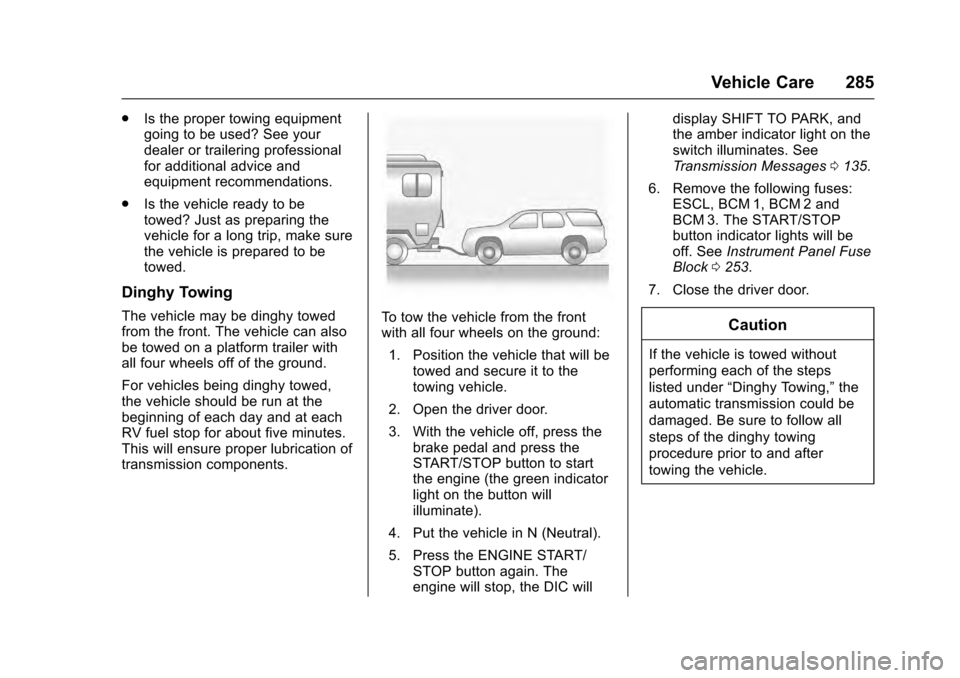
Cadillac SRX Owner Manual (GMNA-Localizing-MidEast-9369636) - 2016 -
crc - 6/1/15
Vehicle Care 285
.Is the proper towing equipment
going to be used? See your
dealer or trailering professional
for additional advice and
equipment recommendations.
. Is the vehicle ready to be
towed? Just as preparing the
vehicle for a long trip, make sure
the vehicle is prepared to be
towed.
Dinghy Towing
The vehicle may be dinghy towed
from the front. The vehicle can also
be towed on a platform trailer with
all four wheels off of the ground.
For vehicles being dinghy towed,
the vehicle should be run at the
beginning of each day and at each
RV fuel stop for about five minutes.
This will ensure proper lubrication of
transmission components.To tow the vehicle from the front
with all four wheels on the ground:
1. Position the vehicle that will be towed and secure it to the
towing vehicle.
2. Open the driver door.
3. With the vehicle off, press the brake pedal and press the
START/STOP button to start
the engine (the green indicator
light on the button will
illuminate).
4. Put the vehicle in N (Neutral).
5. Press the ENGINE START/ STOP button again. The
engine will stop, the DIC will display SHIFT TO PARK, and
the amber indicator light on the
switch illuminates. See
Transmission Messages
0135.
6. Remove the following fuses: ESCL, BCM 1, BCM 2 and
BCM 3. The START/STOP
button indicator lights will be
off. See Instrument Panel Fuse
Block 0253.
7. Close the driver door.Caution
If the vehicle is towed without
performing each of the steps
listed under “Dinghy Towing,” the
automatic transmission could be
damaged. Be sure to follow all
steps of the dinghy towing
procedure prior to and after
towing the vehicle.
Page 287 of 319
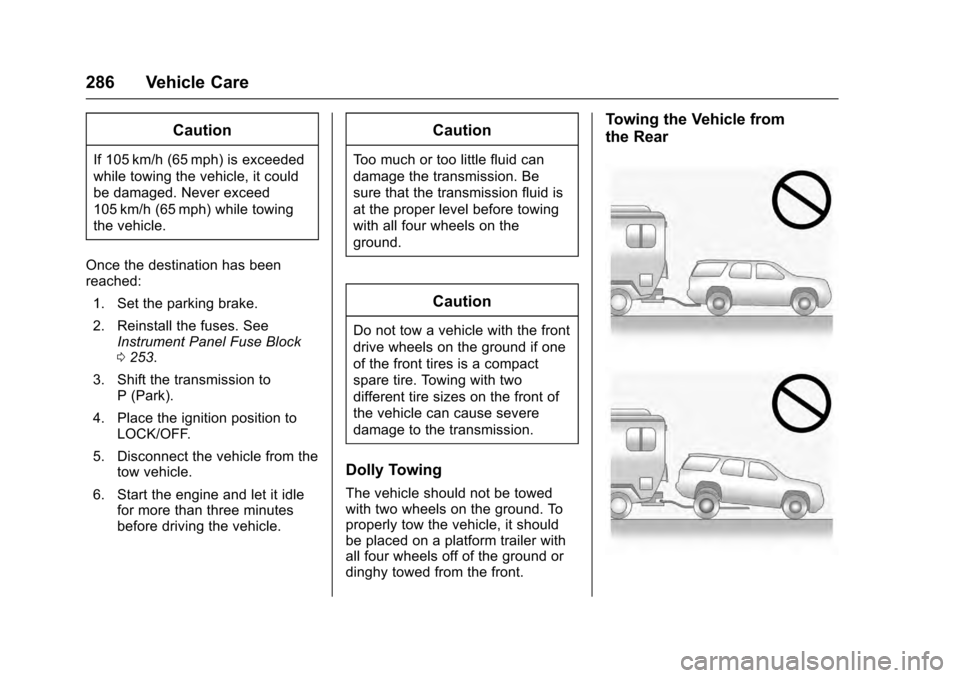
Cadillac SRX Owner Manual (GMNA-Localizing-MidEast-9369636) - 2016 -
crc - 6/1/15
286 Vehicle Care
Caution
If 105 km/h (65 mph) is exceeded
while towing the vehicle, it could
be damaged. Never exceed
105 km/h (65 mph) while towing
the vehicle.
Once the destination has been
reached: 1. Set the parking brake.
2. Reinstall the fuses. See Instrument Panel Fuse Block
0253.
3. Shift the transmission to P (Park).
4. Place the ignition position to LOCK/OFF.
5. Disconnect the vehicle from the tow vehicle.
6. Start the engine and let it idle for more than three minutes
before driving the vehicle.
Caution
Too much or too little fluid can
damage the transmission. Be
sure that the transmission fluid is
at the proper level before towing
with all four wheels on the
ground.
Caution
Do not tow a vehicle with the front
drive wheels on the ground if one
of the front tires is a compact
spare tire. Towing with two
different tire sizes on the front of
the vehicle can cause severe
damage to the transmission.
Dolly Towing
The vehicle should not be towed
with two wheels on the ground. To
properly tow the vehicle, it should
be placed on a platform trailer with
all four wheels off of the ground or
dinghy towed from the front.
Towing the Vehicle from
the Rear
Page 298 of 319
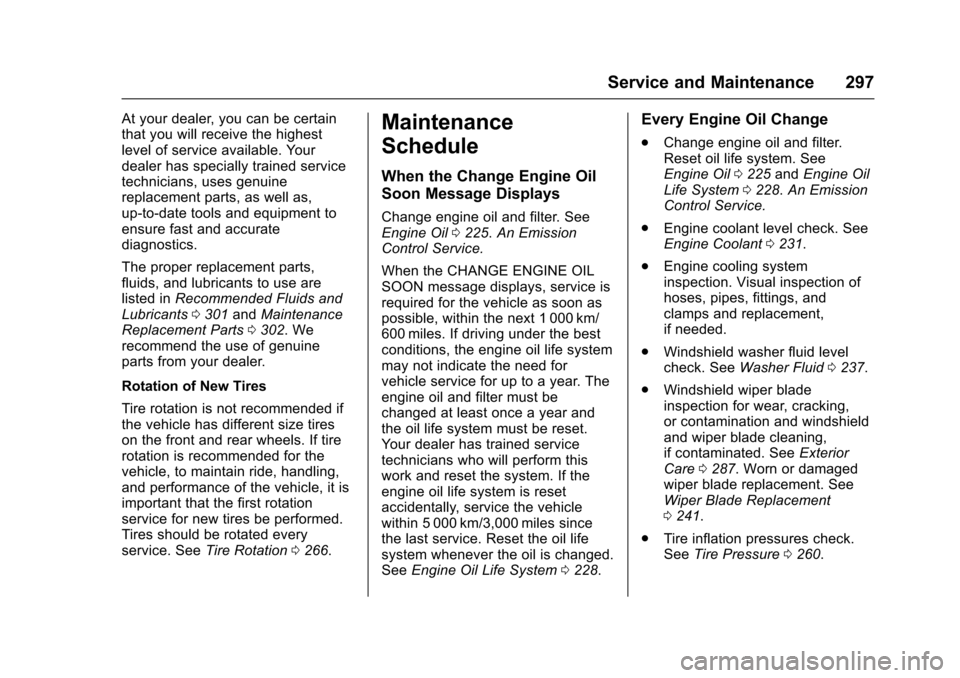
Cadillac SRX Owner Manual (GMNA-Localizing-MidEast-9369636) - 2016 -
crc - 6/1/15
Service and Maintenance 297
At your dealer, you can be certain
that you will receive the highest
level of service available. Your
dealer has specially trained service
technicians, uses genuine
replacement parts, as well as,
up-to-date tools and equipment to
ensure fast and accurate
diagnostics.
The proper replacement parts,
fluids, and lubricants to use are
listed inRecommended Fluids and
Lubricants 0301 andMaintenance
Replacement Parts 0302. We
recommend the use of genuine
parts from your dealer.
Rotation of New Tires
Tire rotation is not recommended if
the vehicle has different size tires
on the front and rear wheels. If tire
rotation is recommended for the
vehicle, to maintain ride, handling,
and performance of the vehicle, it is
important that the first rotation
service for new tires be performed.
Tires should be rotated every
service. See Tire Rotation 0266.Maintenance
Schedule
When the Change Engine Oil
Soon Message Displays
Change engine oil and filter. See
Engine Oil 0225. An Emission
Control Service.
When the CHANGE ENGINE OIL
SOON message displays, service is
required for the vehicle as soon as
possible, within the next 1 000 km/
600 miles. If driving under the best
conditions, the engine oil life system
may not indicate the need for
vehicle service for up to a year. The
engine oil and filter must be
changed at least once a year and
the oil life system must be reset.
Your dealer has trained service
technicians who will perform this
work and reset the system. If the
engine oil life system is reset
accidentally, service the vehicle
within 5 000 km/3,000 miles since
the last service. Reset the oil life
system whenever the oil is changed.
See Engine Oil Life System 0228.
Every Engine Oil Change
.
Change engine oil and filter.
Reset oil life system. See
Engine Oil 0225 and Engine Oil
Life System 0228. An Emission
Control Service.
. Engine coolant level check. See
Engine Coolant 0231.
. Engine cooling system
inspection. Visual inspection of
hoses, pipes, fittings, and
clamps and replacement,
if needed.
. Windshield washer fluid level
check. See Washer Fluid 0237.
. Windshield wiper blade
inspection for wear, cracking,
or contamination and windshield
and wiper blade cleaning,
if contaminated. See Exterior
Care 0287. Worn or damaged
wiper blade replacement. See
Wiper Blade Replacement
0 241.
. Tire inflation pressures check.
See Tire Pressure 0260.
Page 299 of 319
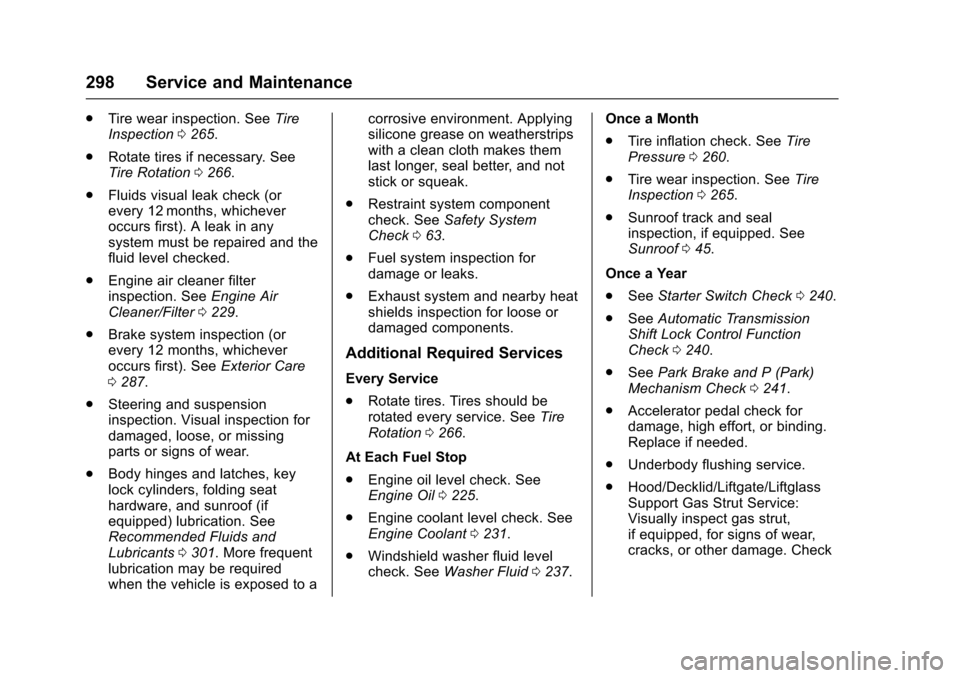
Cadillac SRX Owner Manual (GMNA-Localizing-MidEast-9369636) - 2016 -
crc - 6/1/15
298 Service and Maintenance
.Tire wear inspection. See Tire
Inspection 0265.
. Rotate tires if necessary. See
Tire Rotation 0266.
. Fluids visual leak check (or
every 12 months, whichever
occurs first). A leak in any
system must be repaired and the
fluid level checked.
. Engine air cleaner filter
inspection. See Engine Air
Cleaner/Filter 0229.
. Brake system inspection (or
every 12 months, whichever
occurs first). See Exterior Care
0 287.
. Steering and suspension
inspection. Visual inspection for
damaged, loose, or missing
parts or signs of wear.
. Body hinges and latches, key
lock cylinders, folding seat
hardware, and sunroof (if
equipped) lubrication. See
Recommended Fluids and
Lubricants 0301. More frequent
lubrication may be required
when the vehicle is exposed to a corrosive environment. Applying
silicone grease on weatherstrips
with a clean cloth makes them
last longer, seal better, and not
stick or squeak.
. Restraint system component
check. See Safety System
Check 063.
. Fuel system inspection for
damage or leaks.
. Exhaust system and nearby heat
shields inspection for loose or
damaged components.
Additional Required Services
Every Service
.Rotate tires. Tires should be
rotated every service. See Tire
Rotation 0266.
At Each Fuel Stop
. Engine oil level check. See
Engine Oil 0225.
. Engine coolant level check. See
Engine Coolant 0231.
. Windshield washer fluid level
check. See Washer Fluid 0237. Once a Month
.
Tire inflation check. See Tire
Pressure 0260.
. Tire wear inspection. See Tire
Inspection 0265.
. Sunroof track and seal
inspection, if equipped. See
Sunroof 045.
Once a Year
. See Starter Switch Check 0240.
. See Automatic Transmission
Shift Lock Control Function
Check 0240.
. See Park Brake and P (Park)
Mechanism Check 0241.
. Accelerator pedal check for
damage, high effort, or binding.
Replace if needed.
. Underbody flushing service.
. Hood/Decklid/Liftgate/Liftglass
Support Gas Strut Service:
Visually inspect gas strut,
if equipped, for signs of wear,
cracks, or other damage. Check
Page 300 of 319
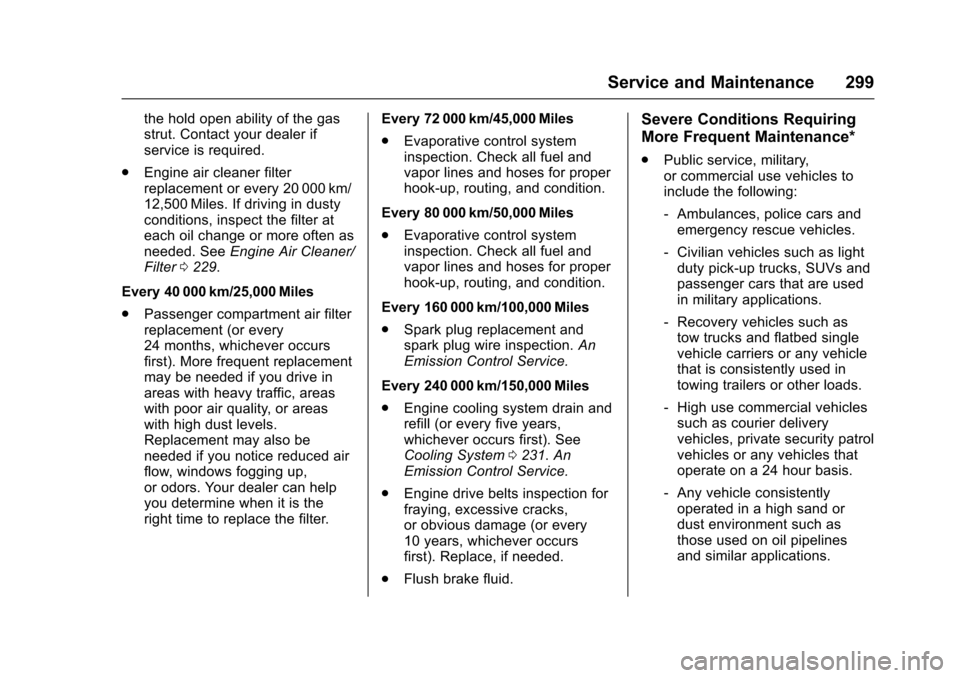
Cadillac SRX Owner Manual (GMNA-Localizing-MidEast-9369636) - 2016 -
crc - 6/1/15
Service and Maintenance 299
the hold open ability of the gas
strut. Contact your dealer if
service is required.
. Engine air cleaner filter
replacement or every 20 000 km/
12,500 Miles. If driving in dusty
conditions, inspect the filter at
each oil change or more often as
needed. See Engine Air Cleaner/
Filter 0229.
Every 40 000 km/25,000 Miles
. Passenger compartment air filter
replacement (or every
24 months, whichever occurs
first). More frequent replacement
may be needed if you drive in
areas with heavy traffic, areas
with poor air quality, or areas
with high dust levels.
Replacement may also be
needed if you notice reduced air
flow, windows fogging up,
or odors. Your dealer can help
you determine when it is the
right time to replace the filter. Every 72 000 km/45,000 Miles
.
Evaporative control system
inspection. Check all fuel and
vapor lines and hoses for proper
hook-up, routing, and condition.
Every 80 000 km/50,000 Miles
. Evaporative control system
inspection. Check all fuel and
vapor lines and hoses for proper
hook-up, routing, and condition.
Every 160 000 km/100,000 Miles
. Spark plug replacement and
spark plug wire inspection. An
Emission Control Service.
Every 240 000 km/150,000 Miles
. Engine cooling system drain and
refill (or every five years,
whichever occurs first). See
Cooling System 0231. An
Emission Control Service.
. Engine drive belts inspection for
fraying, excessive cracks,
or obvious damage (or every
10 years, whichever occurs
first). Replace, if needed.
. Flush brake fluid.Severe Conditions Requiring
More Frequent Maintenance*
.Public service, military,
or commercial use vehicles to
include the following:
‐Ambulances, police cars and
emergency rescue vehicles.
‐ Civilian vehicles such as light
duty pick-up trucks, SUVs and
passenger cars that are used
in military applications.
‐ Recovery vehicles such as
tow trucks and flatbed single
vehicle carriers or any vehicle
that is consistently used in
towing trailers or other loads.
‐ High use commercial vehicles
such as courier delivery
vehicles, private security patrol
vehicles or any vehicles that
operate on a 24 hour basis.
‐ Any vehicle consistently
operated in a high sand or
dust environment such as
those used on oil pipelines
and similar applications.
Page 302 of 319
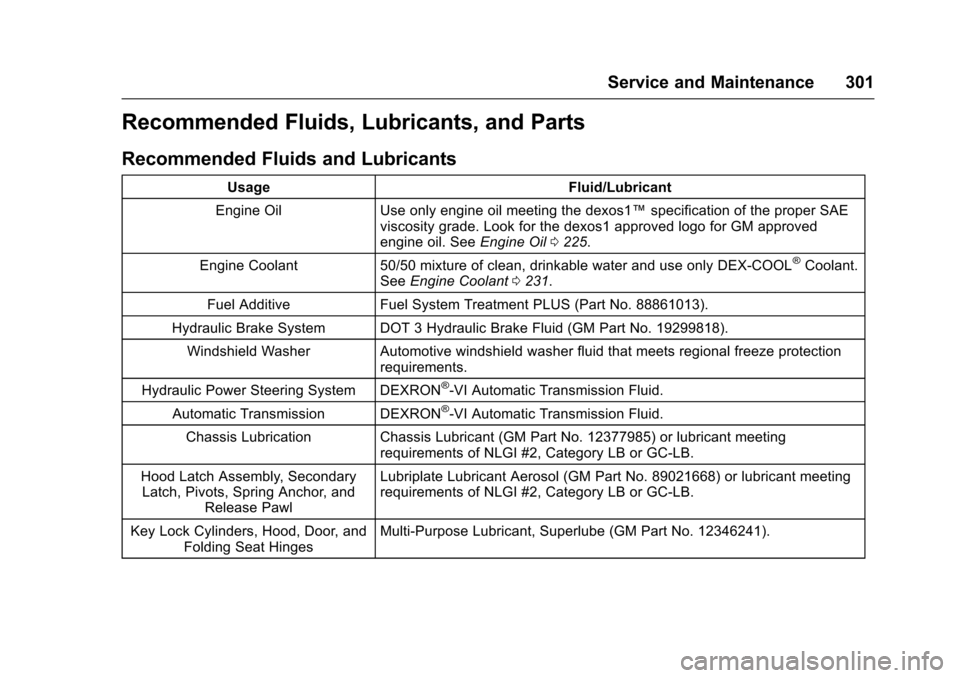
Cadillac SRX Owner Manual (GMNA-Localizing-MidEast-9369636) - 2016 -
crc - 6/1/15
Service and Maintenance 301
Recommended Fluids, Lubricants, and Parts
Recommended Fluids and Lubricants
UsageFluid/Lubricant
Engine Oil Use only engine oil meeting the dexos1™ specification of the proper SAE
viscosity grade. Look for the dexos1 approved logo for GM approved
engine oil. See Engine Oil0225.
Engine Coolant 50/50 mixture of clean, drinkable water and use only DEX-COOL
®Coolant.
See Engine Coolant 0231.
Fuel Additive Fuel System Treatment PLUS (Part No. 88861013).
Hydraulic Brake System DOT 3 Hydraulic Brake Fluid (GM Part No. 19299818). Windshield Washer Automotive windshield washer fluid that meets regional freeze protection requirements.
Hydraulic Power Steering System DEXRON
®-VI Automatic Transmission Fluid.
Automatic Transmission DEXRON
®-VI Automatic Transmission Fluid.
Chassis Lubrication Chassis Lubricant (GM Part No. 12377985) or lubricant meeting requirements of NLGI #2, Category LB or GC-LB.
Hood Latch Assembly, Secondary Latch, Pivots, Spring Anchor, and
Release Pawl Lubriplate Lubricant Aerosol (GM Part No. 89021668) or lubricant meeting
requirements of NLGI #2, Category LB or GC-LB.
Key Lock Cylinders, Hood, Door, and Folding Seat Hinges Multi-Purpose Lubricant, Superlube (GM Part No. 12346241).